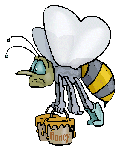 Bee Facts & Information
Bee Facts & Information  Bee Facts & Information
Bee Facts & Information
| Be | Warned | You | Require | Gloves | This mnemonic helps remember it. | |
| Blue | White | Yellow | Red | Green | ||
| 0 | 1 | 2 | 3 | 4 | The Numbers are matched with the year end number. e.g. 1999 is Green, 2000 is Blue, etc. | |
| 5 | 6 | 7 | 8 | 9 |